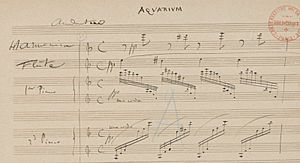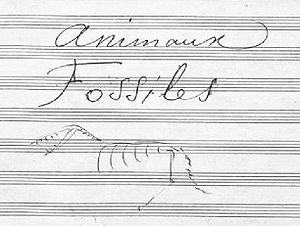The Carnival of the Animals facts for kids
The Carnival of the Animals (which means Le Carnaval des animaux in French) is a fun and clever musical piece. It was written by the French composer Camille Saint-Saëns in 1886. This work is a "suite," which means it's a collection of fourteen short musical pieces, called movements. Each movement is about a different animal or group of animals.
Saint-Saëns wrote this music for a private party, so it wasn't meant to be played in big concerts at first. It uses two pianos and other instruments, and the whole piece lasts about 25 minutes.
Contents
- The Animal Movements
- I. Introduction et marche royale du lion (Introduction and Royal March of the Lion)
- II. Poules et coqs (Hens and Roosters)
- III. Hémiones (animaux véloces) (Wild Donkeys Swift Animals)
- IV. Tortues (Tortoises)
- V. L'Éléphant (The Elephant)
- VI. Kangourous (Kangaroos)
- VII. Aquarium
- VIII. Personnages à longues oreilles (Characters with Long Ears)
- IX. Le Coucou au fond des bois (The Cuckoo in the Depths of the Woods)
- X. Volière (Aviary)
- XI. Pianistes (Pianists)
- XII. Fossiles (Fossils)
- XIII. Le cygne (The Swan)
- XIV. Final (Finale)
- Musical Jokes and References
- Ogden Nash's Verses
- Famous Performances
- Images for kids
- See also
The Animal Movements
There are fourteen movements in The Carnival of the Animals, each bringing a different animal to life through music!
I. Introduction et marche royale du lion (Introduction and Royal March of the Lion)
This movement starts with a grand introduction. The pianos play a bold, rumbling sound, and the strings (like violins and cellos) play a majestic tune. The pianos then play a march that sounds like a lion proudly walking. Sometimes, the pianos make low, growling sounds, like a lion's roar.
II. Poules et coqs (Hens and Roosters)
Listen closely, and you'll hear the sounds of chickens! The pianos and strings play a pecking sound, like hens looking for food. A clarinet plays a short solo, and the piano then makes a very fast sound that reminds you of a rooster crowing "Cock-a-Doodle-Doo!"
III. Hémiones (animaux véloces) (Wild Donkeys Swift Animals)
This movement is super fast! It's played by two pianos, and they create the feeling of wild donkeys, called dziggetai, running at top speed. These donkeys are known for being incredibly quick.
IV. Tortues (Tortoises)
Imagine a slow-motion race! This funny movement starts with a piano playing a steady beat. Then, the strings play a very slow version of a famous fast dance tune called the "Can-can" from an opera called Orphée aux enfers. It's a joke because the "Can-can" is usually played super fast, but here it's like a tortoise trying to dance!
V. L'Éléphant (The Elephant)
This section is big and grand, just like an elephant! A double bass (the biggest string instrument) plays a slow, waltz-like tune, while the piano plays a bouncy rhythm. It's another musical joke! Saint-Saëns took melodies that were originally written for light, high-pitched instruments (like flutes) and gave them to the lowest, heaviest instrument, the double bass.
VI. Kangourous (Kangaroos)
You can almost see the kangaroos hopping! Two pianos play chords that jump up and down. When the chords go higher, they get faster and louder, like a kangaroo leaping. When they go lower, they get slower and softer, as if it's landing gently.
VII. Aquarium
This movement sounds like a peaceful, dimly lit aquarium. The flute plays a beautiful melody, while the strings and pianos create rippling, watery sounds. Sometimes, a glass harmonica (or a celesta or glockenspiel) adds sparkling notes, making you think of fish swimming and light reflecting in the water.
VIII. Personnages à longues oreilles (Characters with Long Ears)
This is the shortest movement, played by two violins. They make sounds that go high and loud, then low and buzzing, like a donkey's "hee-haw." Some people think Saint-Saëns was making a joke about music critics, comparing them to braying donkeys!
IX. Le Coucou au fond des bois (The Cuckoo in the Depths of the Woods)
In this movement, the pianos play soft, quiet chords, while a clarinet plays just two notes over and over again: C and A-flat. This sounds exactly like a cuckoo bird calling from deep within the woods. Saint-Saëns even wrote that the clarinet player should be offstage, making the sound seem even more distant.
X. Volière (Aviary)
Imagine a busy birdhouse or a jungle full of birds! The high strings create a buzzing background noise. The flute takes the part of a bird, playing a fast, trilling tune that sounds like a bird singing and flying. The pianos add occasional chirps and trills from other birds.
XI. Pianistes (Pianists)
This is a very funny movement that makes fun of pianists! It sounds like piano students practicing their finger exercises and scales. The pianos play scales in different keys, sometimes sounding a bit clumsy, as if a beginner is playing. It's a humorous peek into what pianists do when they practice!
XII. Fossiles (Fossils)
This movement uses the xylophone a lot, which sounds like bones clacking together. Saint-Saëns even uses parts of his own spooky piece, Danse macabre, which is about skeletons dancing. You might also hear bits of famous tunes like "Twinkle, Twinkle, Little Star", "Au clair de la lune", and "Partant pour la Syrie". The joke here is that these old tunes are like "fossils" of music from Saint-Saëns's time.
XIII. Le cygne (The Swan)
This is one of the most famous parts of the suite. A cello plays a beautiful, slow, graceful melody that sounds like a swan gliding smoothly on water. Meanwhile, one piano plays rippling notes, and the other plays gentle chords, which are said to represent the swan's feet quietly paddling beneath the surface. This piece is often played by itself and is very popular for cellists.
XIV. Final (Finale)
The grand finale brings back many of the animals you've heard before! It starts with the same trills as the introduction. Then, a lively main melody begins, full of dazzling scales and trills from the pianos. You'll hear the lion, the donkeys, the hens, and the kangaroos again. The piece ends with six "Hee Haws" from the donkeys, as if they're getting the last laugh, before a strong final chord.
Musical Jokes and References
The Carnival of the Animals is full of musical jokes and hidden references!
- In Poules et coqs, Saint-Saëns uses a theme from an older piece called "The Hen," but he makes it sound much less elegant and more like a real chicken.
- Pianistes makes fun of piano students practicing their scales, sometimes even sounding a bit clumsy on purpose.
- Tortues plays the super-fast "Can-can" tune at a very slow, dragging pace, which is quite funny.
- L'éléphant takes a light, airy tune and gives it to the big, heavy double bass, making it sound very different.
- Fossiles is packed with old tunes like "Twinkle, Twinkle, Little Star" and "Au clair de la lune", plus parts of Saint-Saëns's own "Danse macabre". These old melodies are the "fossils" of music.
- The Personnages à longues oreilles (Characters with Long Ears) section, with its donkey-like sounds, is thought to be a playful jab at music critics.
Ogden Nash's Verses
In 1949, a writer named Ogden Nash wrote funny poems to go along with each movement of The Carnival of the Animals. These poems are often read before each piece when the music is performed today. For example, here's part of his poem for "Fossils":
- At midnight in the museum hall
- The fossils gathered for a ball
- There were no drums or saxophones,
- But just the clatter of their bones,
- A rolling, rattling, carefree circus
- Of mammoth polkas and mazurkas.
- Pterodactyls and brontosauruses
- Sang ghostly prehistoric choruses.
- Amid the mastodontic wassail
- I caught the eye of one small fossil.
- "Cheer up, sad world," he said, and winked—
- "It's kind of fun to be extinct."
Famous Performances
The Carnival of the Animals has been used in many fun ways:
- In 1976, Warner Brothers made a TV special called Bugs and Daffy's Carnival of the Animals, where Bugs Bunny and Daffy Duck were the pianists!
- The "Aquarium" and "Finale" movements were used in the "Impressions de France" film at Epcot in Walt Disney World.
- In 2000, the finale was used in the Walt Disney Animation Studios movie Fantasia 2000. It showed a funny animation of a flamingo playing with a yo-yo.
- In 2016, The Wiggles released their own version of The Carnival of the Animals, narrated by Simon Pryce, to help kids learn about classical music.
- In 2020, the famous cellist Sheku Kanneh-Mason and his family recorded a version with narration by actress Olivia Colman.
Images for kids
[[scores:{{{id}}}|The Carnival of the Animals]]: Free scores at the International Music Score Library Project
See also
 In Spanish: El carnaval de los animales para niños
In Spanish: El carnaval de los animales para niños






